Meteora: Cliff Monasteries and Warrior Monks
Meteora is located in central Greece, hidden in the rural mountainous area most tourists skip in favor of sunny Aegean islands and Athenian ruins. I first wrote this post while I was visiting Meteora monasteries, and now, I have traveled there four times. So I have a lot more info to share with you for a Meteora visit!
I had heard that Meteora is a deeply spiritual place, with monasteries built high into towering cliffsides, and low-hanging mists frequently cloaking the rocks. But I didn’t know much more than that.
Disclaimer: Lose the Map contains affiliate links and is a member of Amazon Services LLC Associates Program. If you make a purchase through an affiliate link, I receive a small commission at no extra cost to you.
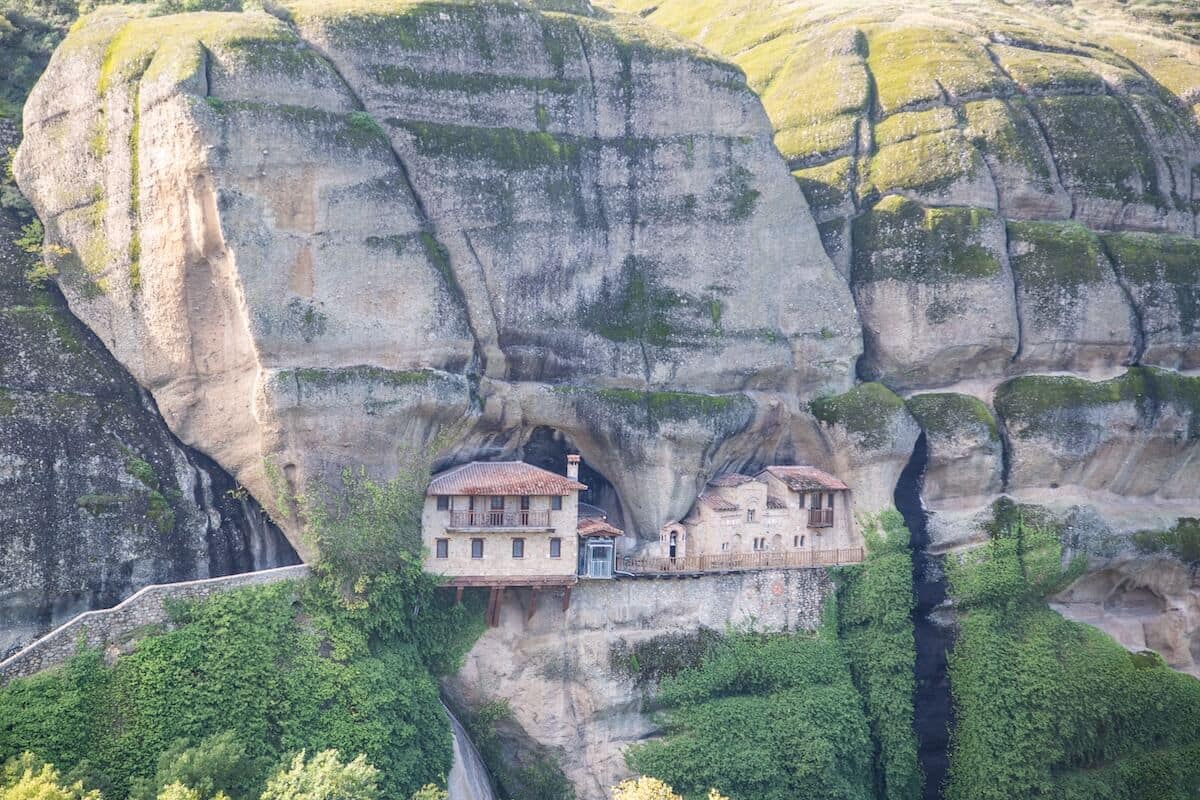
Visiting Meteora Monasteries: On Foot
I got into Meteora at 8 PM after a long road trip from Athens, way after the sun had set. It added to my excitement because I really wasn’t able to see the monasteries above the town I was staying in (Kalambaka) until dawn. The next morning, I was fortunate (?) enough to be led on a 6-mile hike through this unique cultural site by local tour guide/rock climber/hiker Lazaros Botelis, courtesy of Visit Meteora.
The hiking trail was manageable for me, and probably quite easy for people who frequently drop phrases like “CrossFit” and “reps” in their conversations.
- Hotels: Book incredible hotels near Meteora
- I stayed at Dellas Boutique Hotel – affordable and between Kalambaka and Kastraki – and loved it!
- Rental Cars: Rent a car for Meteora with LocalRent
- Tours: Use GetYourGuide in Meteora to explore the city and its history
- Travel Insurance: For a quick vacation, or an extended remote work trip, Travelex Insurance is the best
- Group Trip: If you’d rather combine Meteora with highlights of mainland Greece, check out G Adventures!
- Hiking: Meteora trails can get tricky, so I like using AllTrails to help
We started at the base of the cliffs just as the morning sun was getting high enough to hit the valley floor. The shafts of light streaming down made the whole landscape look like a still life, rather than a real-world place.
Our guide Lazaros, obviously a “morning person”, easily sprinted ahead showing us the trail while I was still trying to get my eyes fully open. That’s when we caught our first close-up glimpse of the strangely grooved rocks the monasteries were built on. And, of course, the monastery on a cliff perched right above it.
According to Lazaros, recent findings showed that the whole area of Meteora used to be underwater. The water currents are assumed to be what caused the strange lines on the towering cliffs.
First Monastery Sighting
Heading further into the forest, we came upon a monastery inserted so far into a rockface, that it looked like it had been jammed in. Meteora definition: “suspended in the air”. One glance at these monasteries makes it easy to see why.
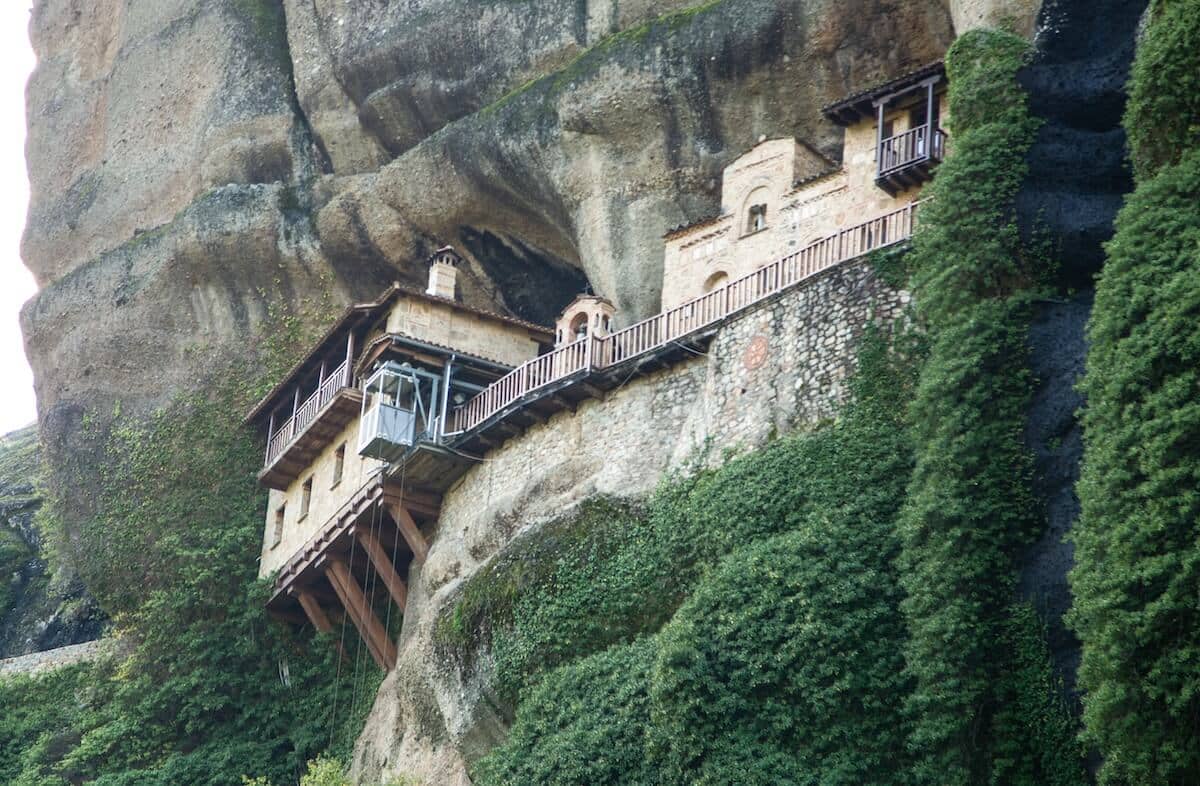
The small blue rectangle in the center is an elevator to get the monks up and down from the seemingly inaccessible building. Of course, the elevators were installed relatively recently; before that, the monks put themselves in what looked like huge handbaskets and pulled on a rope to hoist themselves up. The idea was to be as isolated as possible to focus on religious duties. I would assume living in a rock wall accomplishes this quite well.
As we continued down the trail, the next turn took us away from the cliffs and deeper into the forest, which was beautiful in its own right.
A Walk Through the Forest
Lazaros proved knowledgeable about the forest, as he happily explained in great detail exactly how many species of mushrooms we were passing that could kill us. In just a few minutes. Did I mention we were also looking for mushrooms during our hike to cook for dinner? And trying not to get the different species confused?

As we stopped to pick up one last batch of mushrooms we found, we heard clanging bells and looked up to see a herd of about 200 goats crossing the trail in front of us. Oh, the traffic jams of the Greek countryside.
It was such a representative moment of walking through the forest in Greece; clanging bells and the distant baaing of goats, the smell of pinecones and the feeling of a pebbled dirt trail underneath my feet, topped off by a slight moisture hanging in the air from the rains the night before. They were the smells and sights I had experienced so many times before in my childhood when I would venture into the forest right behind my house outside Athens.
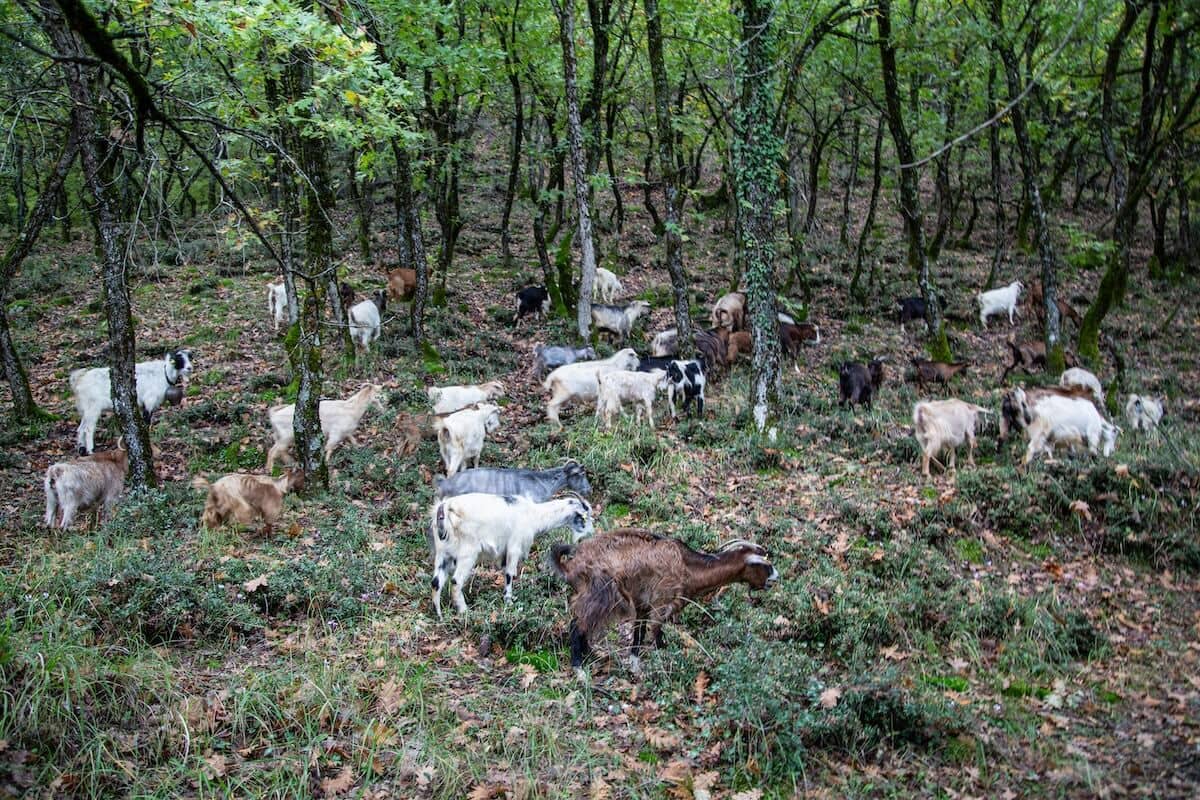
I came out of my nostalgic daydreaming and saw the final goat leave the trail (after leaving us a little gift). We walked on, and the incline kept getting steeper, until we reached what looked like a peak. After one last turn, we were out of the forest, and the view I saw below me was incredible.
The town of Kalambaka was laid out before us, with giant cliffs towering over the houses through the haze. On the edge of the hill we were standing on, the statue of a proud monk stood with a plaque before him, and a cross stuck into the ground further back.
History of Meteora: Warrior Monks
The monk memorialized by the statue is Papathymios Vlahavas, a key figure in the Greek Revolution against the Ottoman Empire. He was described to us by our guide as a “warrior monk”, which sounds like something you level up to in World of Warcraft, but was a real thing in Meteora around the time of the Greek War of Independence. Monks from Meteora played an important part in rallying the local Greeks against the Ottomans.
After resting, admiring the view, and catching our breath, I continued on hoping to get my first glimpse of the monasteries from up high. We rounded one last bend around the hill, got hit by the warm autumn sunlight, and were rewarded for our miles of hiking with views like this:
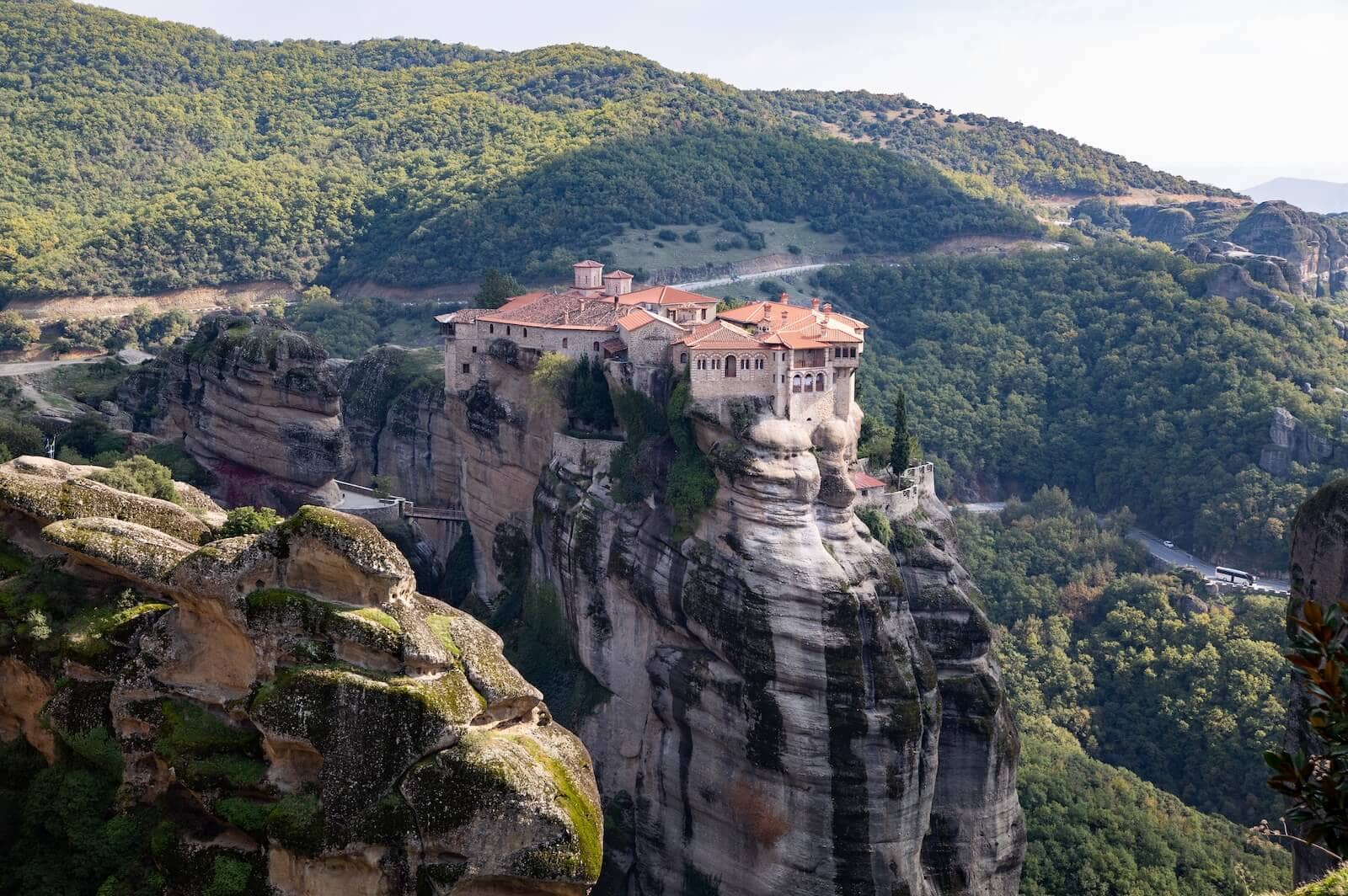
The monasteries looked almost like an extension of the cliff face, as though they spontaneously sprouted out of the top of the rocks to provide an isolated, secure, and silent place for the monks’ religious contemplation. It was a truly surreal view.
Inside the Monasteries Themselves
Our trail eventually met up with the asphalt of the road leading up to the monasteries – you can, in fact, get there by car if a 6-mile hike isn’t your thing – and we walked down to the Great Meteoron Monastery, the main monastery open to visitors. As I rested for a while near the entrance, I noticed the crowd seemed to be a mix of well-dressed Russian visitors (presumably due to Meteora’s importance for the Eastern Orthodox religion), hikers, and Greek priests.
I then saw a Greek priest with his flowing black robes and foot-long beard take a selfie in front of the monastery, came to the realization that it’s really not just my generation, and decided maybe it was time to leave the crowd and go inside.
How to Visit the Meteora Monasteries
Meteora Dress Code
Since it’s not only a UNESCO site, but a sacred religious site, you may want to pack conservatively when you’re wondering what to wear to Meteora.
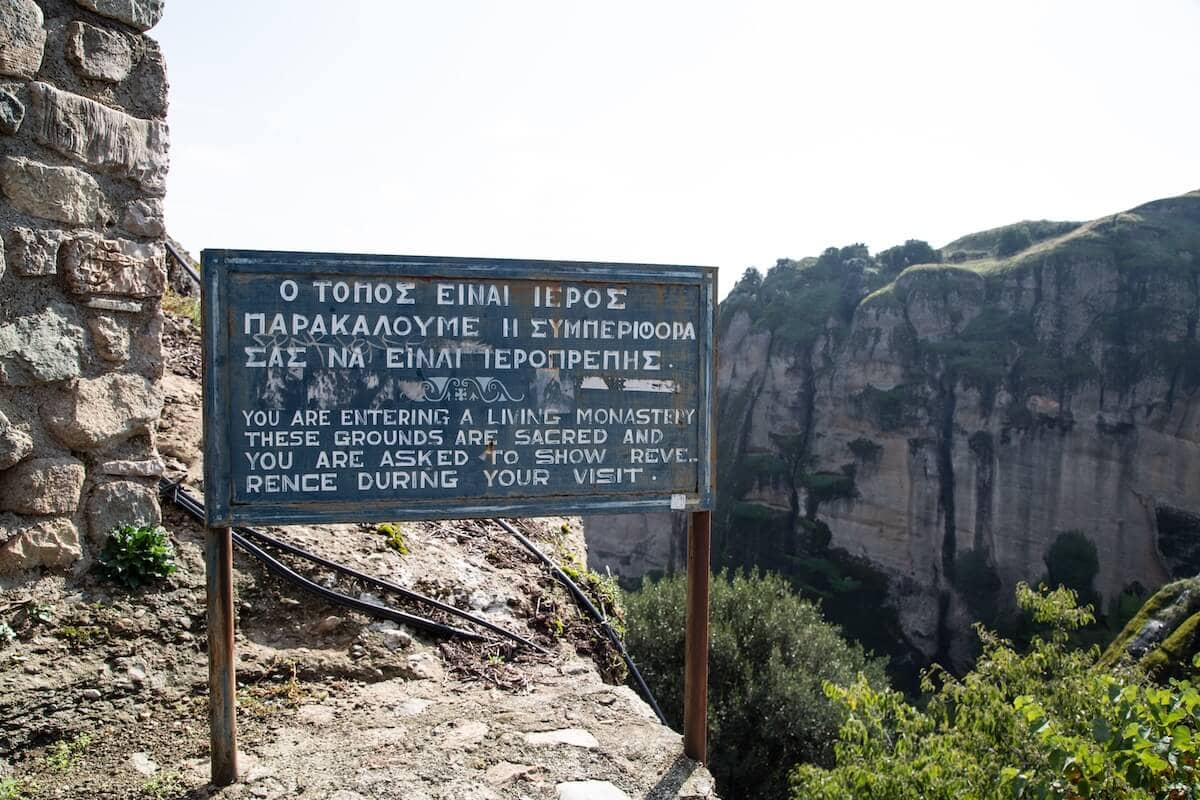
The monastery demands a respectful code of conduct, and both men and women are expected to be appropriately covered and dressed. Even in the hot summer months. Wrap-around skirts are provided for women who enter with pants, as is common in many religious sites. To veer off topic for a second, I never understood as a concept. Don’t pants actually provide more coverage than a skirt? Anyway, if you know more about religious rules than I do – which is almost a certainty – please explain in the comments.
Both genders should ideally have shoulders and knees covered for a Meteora visit. And, of course, it’s best to avoid being particularly loud, cursing, or bringing in any outside food or drink.
Meteora Opening Hours and Fees
One of the monasteries will be closed, depending on the day – part of the reason I recommend a two-day visit if you want to see them all. The monasteries’ hours also differ between winter and spring. Here is the latest timetable, although I always recommend checking out the VisitMeteora website before visiting to make sure it’s still accurate.
|
Season |
Great Meteoron Monastery |
Roussanou Monastery |
Holy Trinity Monastery |
Varlaam Monastery |
Agios Nikolaos Anapafsas Monastery |
St. Stephen’s Nunnery |
|
April 1 – October 31 |
09:30 to 15:00 Closed Tuesday |
09:00 to 15:30 (15:00 on Sundays). |
10:00 to 16:00 |
09:00 to 16:00 |
09:00 to 17:00 |
9:00 to 13:30 and 15:30 to 17:30 Closed Mondays |
|
November 1 – March 31 |
09:30 to 14:00 |
09:30 to 14:00. |
10:00 to 16:00. |
09:00 to 15:00 |
09:00 to 16:00, Sundays: 9:30 to 16:00. |
9:30 to 13:00 and 15:00 to 17:00. |
Entrance fee: Entrance is free for Greeks, and 3 Euros for tourists.
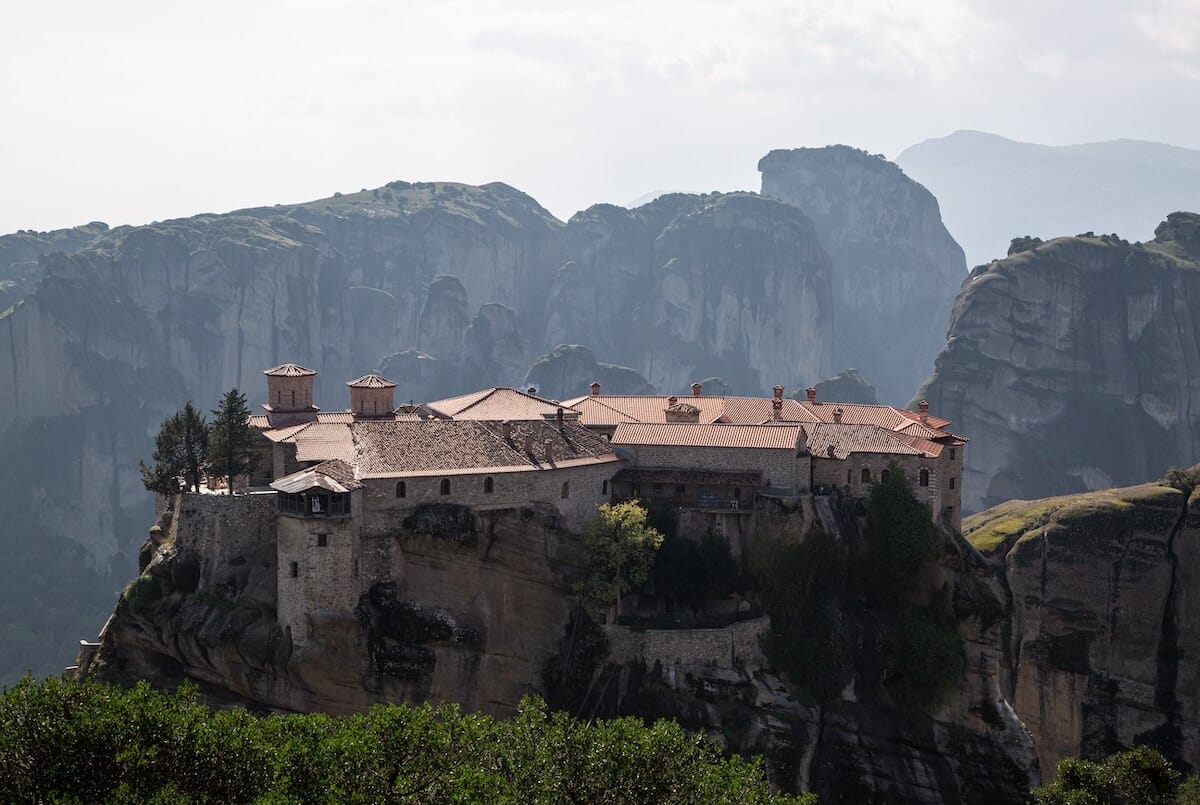
Great Meteoron Monastery and Museum
The first part of the monastery has an intriguing little museum space, that explains the history of the area, showcases artwork featured in the monasteries over the years, and contains an impressive display of uniforms, newspaper articles, and other artifacts from the Greek War of Independence.
The courtyard of the Great Meteoron Monastery also had some impressive murals and structures to check out. Since I grew up attending the Greek Orthodox church (about twice a year, but still), I’m quite used to the painting style found in most such churches. However, I still find the 2-D figures with hands raised, cocked heads, and jewel-tone shrouds uniquely beautiful.
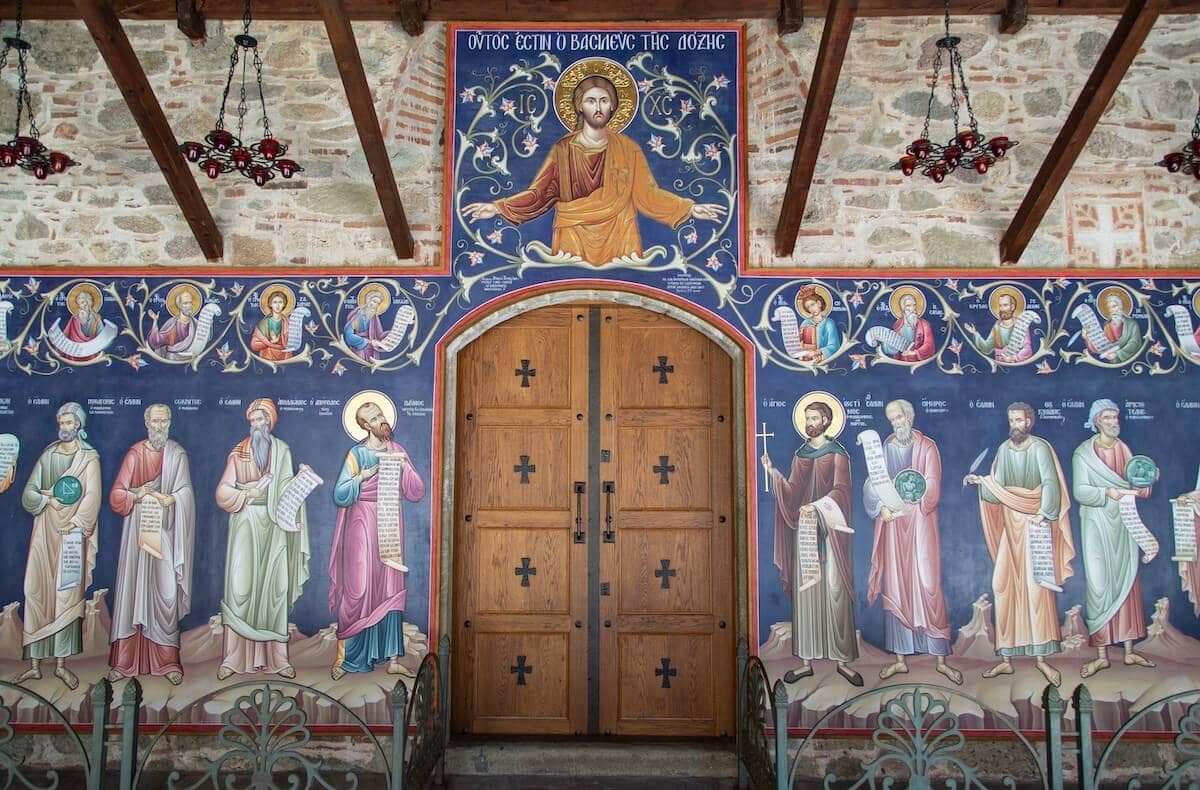
Further into the Grand Meteoron Monastery, I stumbled across a room containing letters from the 15th century onwards, written by monks who lived and died within the monastery walls. I would recommend spending a good chunk of time in this room to any potential visitors, as I would also recommend searching every corner of the courtyard for interesting views of the surrounding landscape.
After taking in as much as I could, I walked out onto a protected ledge outside the monastery, and looked down at the town of Kalambaka.
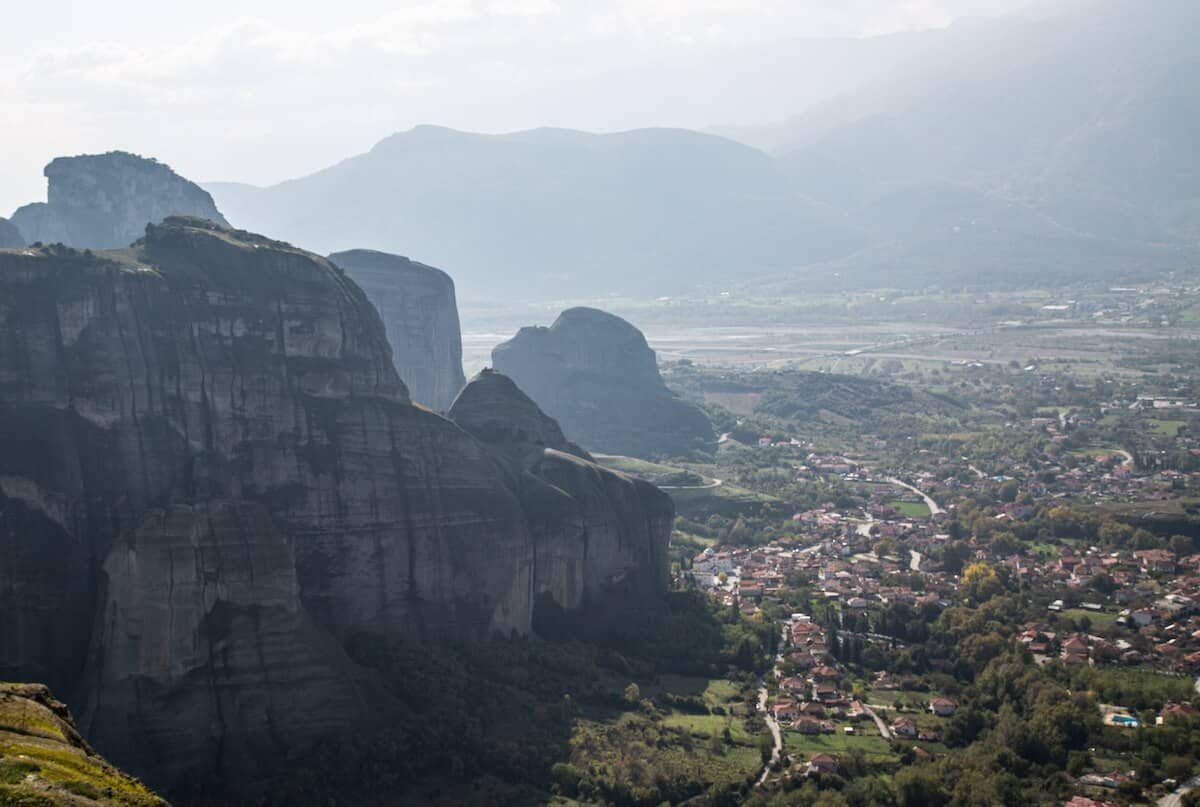
The houses appeared relatively tiny, completely dwarfed by the towering cliffs piercing the atmosphere above them. Since it was late October, and still early in the morning, the haze and clouds at the very top of the peaks were unwilling to disappear entirely, giving the whole landscape a mysterious, almost alien vibe. I breathed in the crisp, mountain air, gazed out into the glowing valley, and decided that moment was the best possible end to my first exciting little adventure in Meteora.
However, thankfully for you guys, I have gone back several times. And have even more tips to give!
Meteora Hikes
First of all, I am incredibly happy I had a guide for my first hike through Meteora because the trails can get a little tricky – and not that well marked. Using AllTrails helps, as it gives you maps of the trails. Some are disconnected from each other.
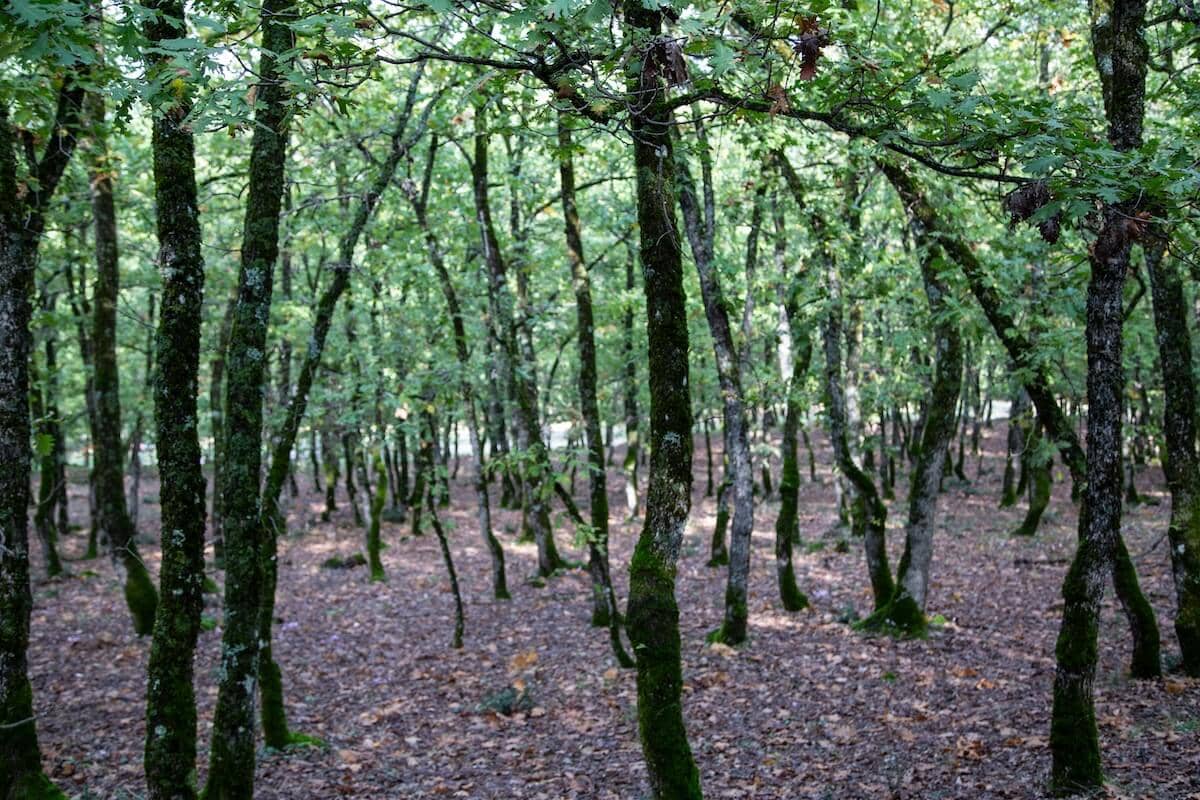
I would rate the trail as a tad easier than moderate. It’s not technically challenging, but it can get tiring, especially the ups and downs on the hillside, and the many, many stairs leading up to the monasteries themselves. Start early in the morning so you can avoid the heat of midday, especially in the summer months. And so you can get to the monasteries just as they’re opening up for the day.
Climbing in Meteora
Meteora has been a great climbing destination for decades, thanks partly to its sheer, strange cliffs. However, climbing has been increasingly restricted in the last few years, particularly on the cliffs that feature the six active monasteries in the area. I would check with the local tourist office before attempting any climbing routes to make sure they’re not prohibited.
Meteora View
There are multiple breathtaking views in the area. Honestly, just driving through the cliffs will have you wanting to stop and jump out for a picture at every turn. But here are some of the best.
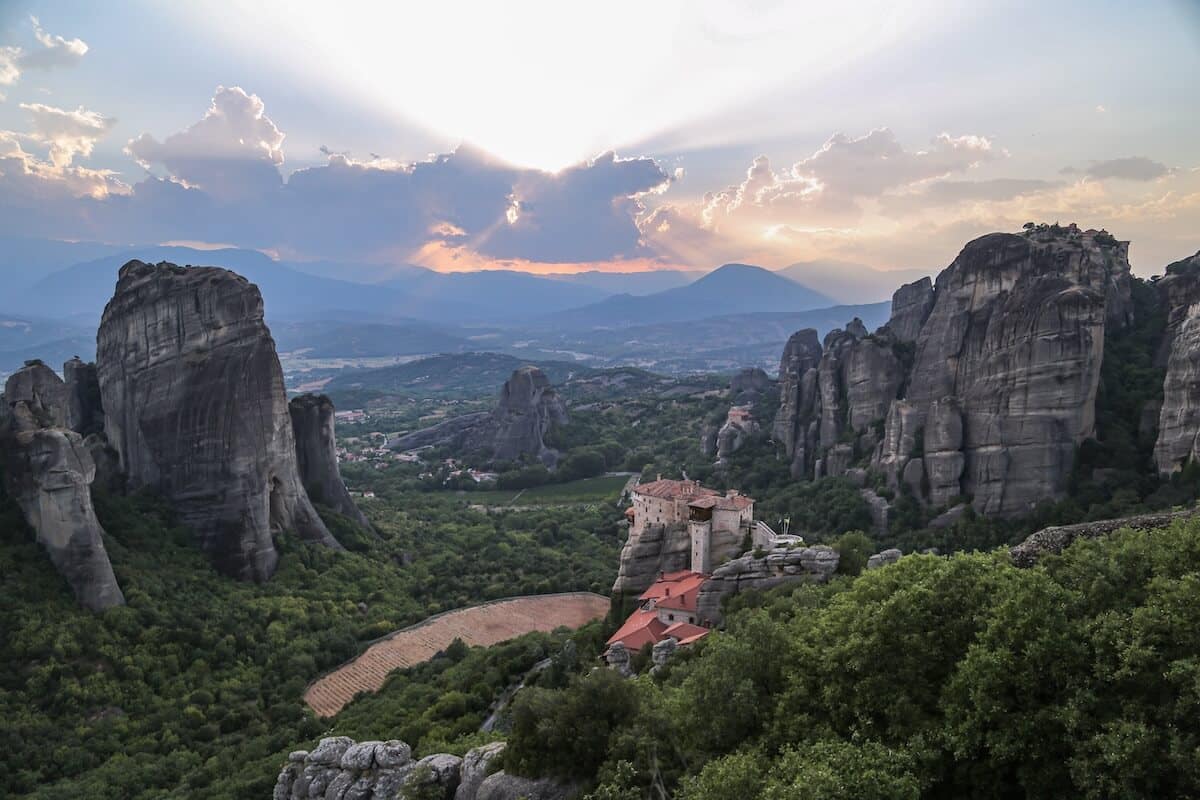
Psaropetra Lookout
A popular place to watch the sunset, Psaropetra literally translates to “fish rock”, and is quite literally a large rock jutting out from the road. It’s a massive rock, so it’s quite safe to walk out onto, but perhaps don’t test your luck by walking all the way out to the cliff face like some other daring tourists do.
Local Tip: Tourists swarm this area by sunset, so make sure you get there half an hour early so you can find parking somewhere along the road. It can be easy to miss the spot; just check where all the cars are lined up by the side of the road.
Main Observation Deck of Meteora
This is the “official” viewpoint of the Meteora area, but it has now become eclipsed by Psaropetra Lookout. If you find the rock too crowded however, you could easily stop here to take pictures as well. It’s just a minute drive away from Psaropetra anyway.
Holy Trinity Monastery
The view from the monastery gardens in Holy Trinity is breathtaking. You get an almost total panoramic view of the entire landscape around you, including the alien-like cliffs and valleys, as well as the neighboring monasteries.
How to Get to Meteora
Most people visit Meteora from one of the two biggest cities in Greece: Athens and Thessaloniki. Here are all the ways you can access the UNESCO World Heritage site.
However, I highly, highly recommend you visit Meteora by car, because once you get there, you’re going to need it anyway. You could get a local taxi, but there are relatively few to book, and you’d rather not have to rely on them for absolutely every single excursion.

Athens to Meteora by Train
Though there is a train station in Kalambaka – the city closest to Meteora – it’s almost impossible to make train connections work from Athens. Greece isn’t the best destination for train travel overall. Which is why most people will take the train to Paleofarsalos (2 hours 45 minutes), and then transfer to a two hour bus to Kalambaka. You can book tickets with Hellenic Train.
Athens to Meteora by Car
The best way to travel to Meteora by far. It takes 3.5-4 hours to drive from Athens to Meteora, depending on what neighborhood you’re traveling from. You can rent a car in Athens here. Having a car will give you maximum flexibility for visiting the monasteries, getting around town, etc.
The roads here are winding and not very wide, so be careful as you drive around, especially if you’re unused to narrower roads.
Athens to Meteora by Bus
You can get a bus from Athens, specifically KTEL Liosion station, to Kalambaka via the city of Trikala. It’s about a 4.5-hour journey to Kalambaka, then a wait of anywhere from 15 minutes to 1.5 hours before a one-hour transfer to Kalambaka.
Local Tip: To avoid the lengthy wait and transfer from Trikala to Kalambaka, most people just disembark at Trikala bus station and take a taxi (20-25 minutes) directly to their hotel in Meteora. I highly recommend this route instead of taking the second bus.
From Thessaloniki to Meteora
You can rent a car in Thessaloniki to get to Meteora’s closest city, Kalambaka, or take the train down to Paleofarsalos, then switch to a bus to Kalambaka. But honestly, the second way is very time-consuming, and a car ride will take just over two hours.
Otherwise, you can take one of the many tours and day trips by bus from Thessaloniki with a company like GetYourGuide.
Meteora Tours
Whether you want a day trip from Athens, a day trip from Thessaloniki, an overnight excursion from Athens, or pretty much any other tour of your choice, there are plenty of local tour options to take you to Meteora and back.

FAQs About Visiting Meteora
Thanks to Visit Meteora for inviting me on this press trip, and a special thanks to George Kourelis for coordinating my visit, and Lazaros Botelis for being our tour guide (and recommending the best souvlaki place in Kalambaka). Even though this was a press trip, all opinions and impressions are my own – I was not paid for this post, and I only endorse destinations I truly enjoy.
What’s one of the most magical places you’ve ever visited?

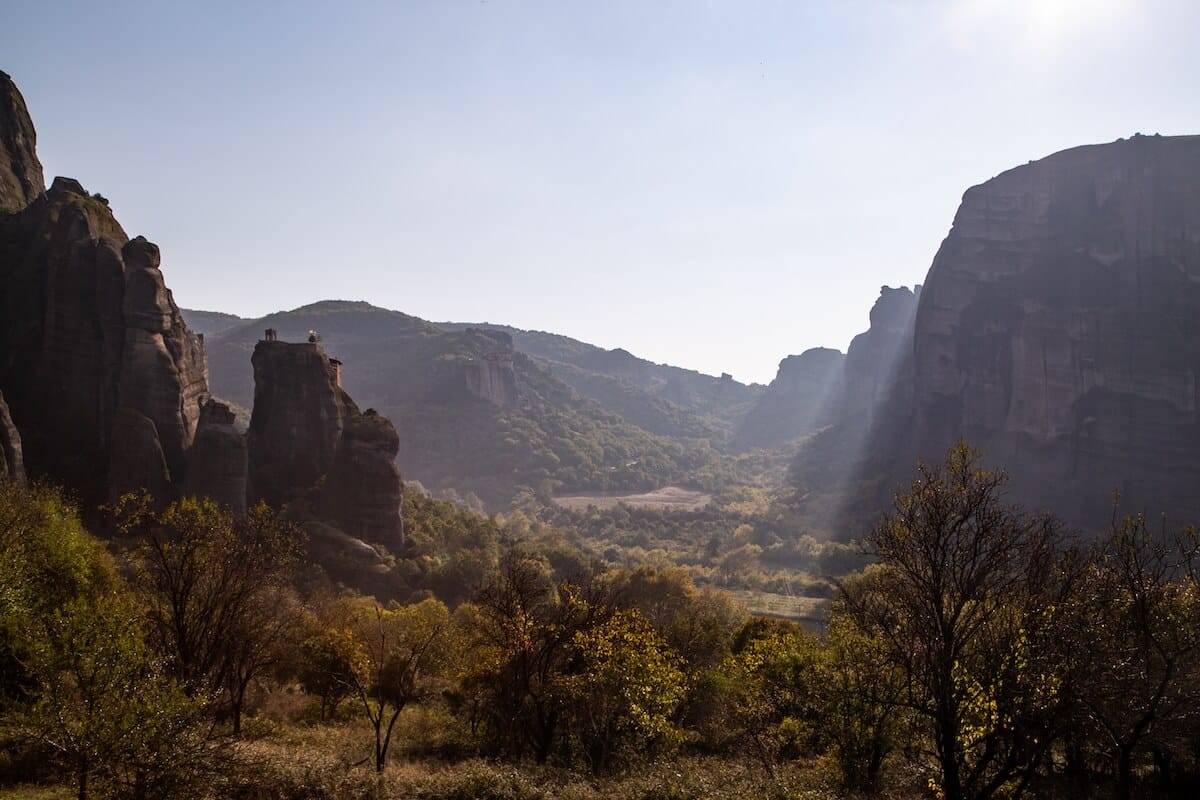
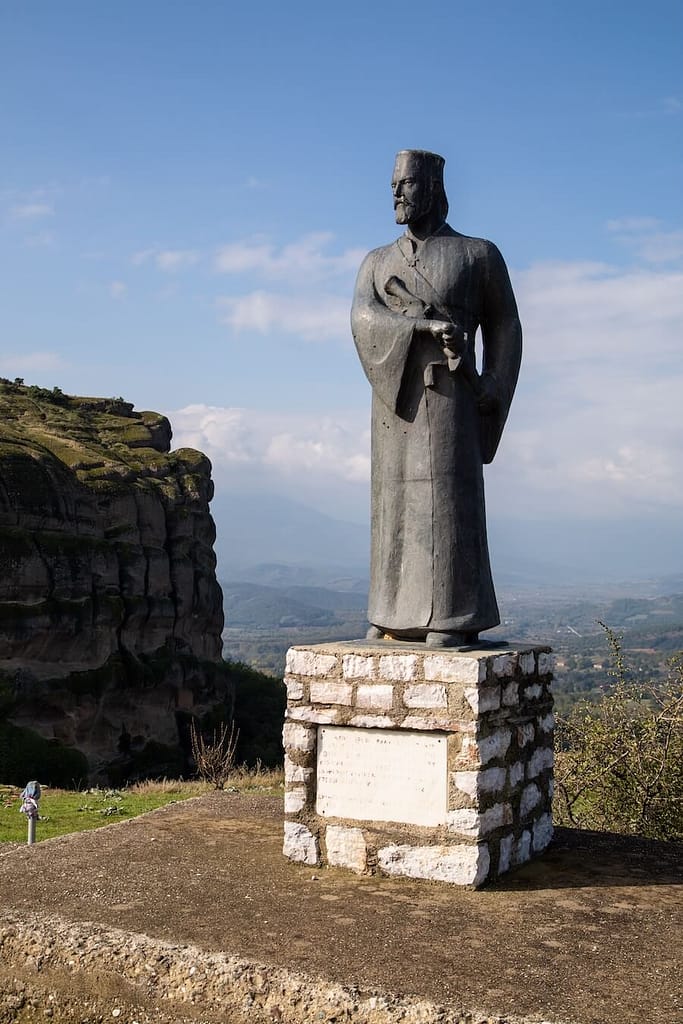
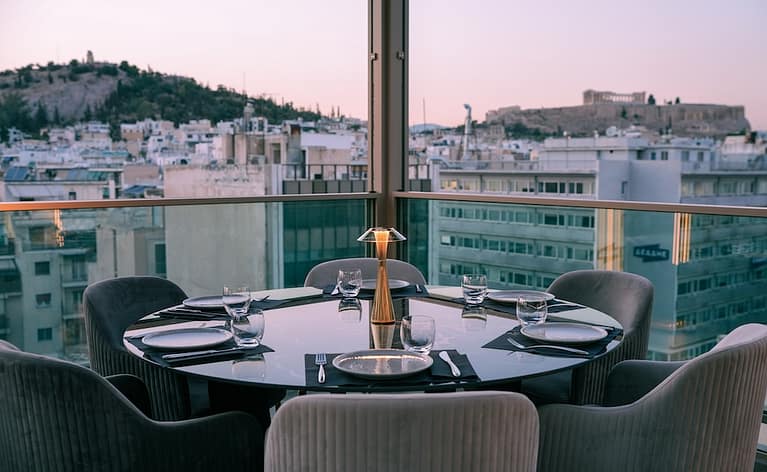
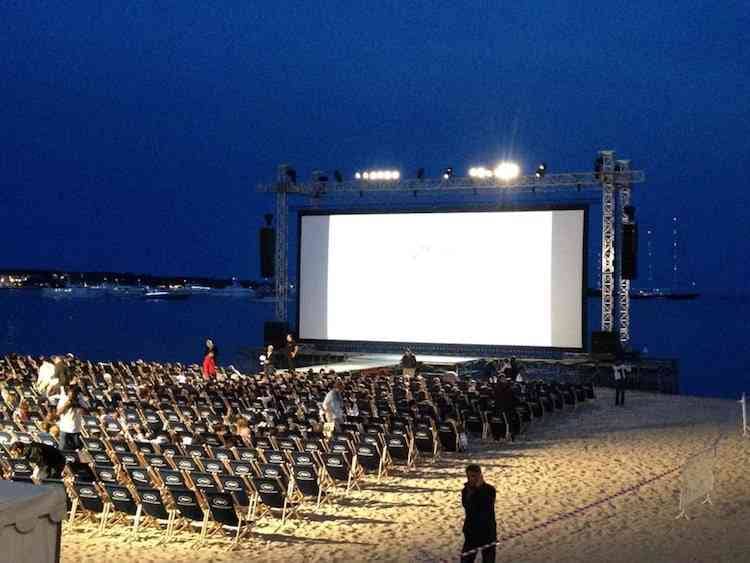


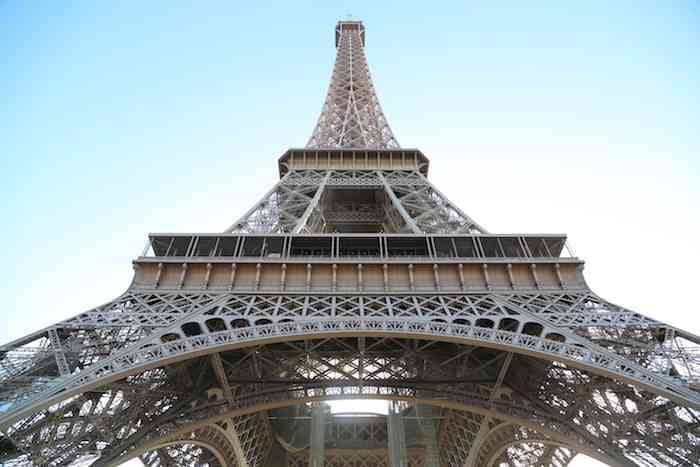

I realize these may be older blog posts, but I am really enjoying reading them :) discovering some places I may not have known about otherwise… I don’t remember exactly how I got here lol, I was reading about mcmurdo station on reddit and then found your post.
Thank you – I’m always so happy to hear that! I hope you continue to follow along :)